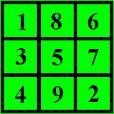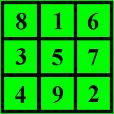In a file named Hw7MoreArrayPractice.java, write each of the following methods along with their corresponding well-designed and aptly-named test methods.
- isAlmostMagicSquare
We will say that a square of numbers is "almost" a magic square if it can be made into a magic square by exactly one swap of two numbers. For example:

This square is not magic because (among other reasons) the first row sums to 15, but the first column sums to 8. However, if we swap the 1 and the 8 we obtain this magic square:

So the first square above, while not a magic square, is an "almost" magic square.
Write the following method:
public static boolean isAlmostMagicSquare(int[][] a)
This method takes a 2d-array of int's and returns true if it represents an almost-magic square, and false otherwise. Note that non-square matrices and null matrices are not magic squares, so your method should return false in these cases.
Note: In solving this problem, you will almost surely want to make use of your isMagicSquare method from the previous assignment.
Also note: magic squares do not have to be 3x3. They can be as small as 1x1 or arbitrarily larger.
- isSudokuRectangle
In the very popular game of Sudoku, players are presented with an N2-by-N2 square board in which they must fill all the cells with the numbers from 1 to N2 such that each row, each column, and each N-by-N "box" contains all the numbers from 1 to N2. For example, if N=3, players get a 9-by-9 board like so:
For this board (again, where N=3), players must fill each 1-by-9 row, each 9-by-1 column, and each 3-by-3 highlighted "box" with the numbers from 1 to 9. Here is a solution for this particular Sudoku:
For more information, read the Wikipedia page on Sudoku:
http://en.wikipedia.org/wiki/Sudoku
Write the following method:
public static boolean isSudokuRectangle(int[][] board,
int row0, int col0,
int row1, int col1)
This method takes a 2d-array of int's (the "board"), and a rectangle on the board defined by its top-left row and column (row0, col0), and its bottom right row and column (row1, col1), and returns true if this rectangular region of the board can be part of a legal Sudoku solution and false otherwise.
Note that this method is only expected to work over rectangular regions defining a single row (so col0 equals col1), a single column (so row0 equals row1), or a single "box" -- so the method returns false if any other rectangle is specified. The method also returns false if the board is null, is not square, or is not N2-by-N2 for some positive integer N.
Also note: if the board is not full, as in the first example above, then the empty spaces will be signified by a 0 in that cell of the board. Thus, this method amounts to checking that all the values in the given rectangle are in the range [0,N2], inclusive, and that none of the values besides 0 occurs more than once.
For your benefit, here are the two Sudoku boards from the examples above:
private static int[][] board1 = {
{ 5, 3, 0, 0, 7, 0, 0, 0, 0 },
{ 6, 0, 0, 1, 9, 5, 0, 0, 0 },
{ 0, 9, 8, 0, 0, 0, 0, 6, 0 },
{ 8, 0, 0, 0, 6, 0, 0, 0, 3 },
{ 4, 0, 0, 8, 0, 3, 0, 0, 1 },
{ 7, 0, 0, 0, 2, 0, 0, 0, 6 },
{ 0, 6, 0, 0, 0, 0, 2, 8, 0 },
{ 0, 0, 0, 4, 1, 9, 0, 0, 5 },
{ 0, 0, 0, 0, 8, 0, 0, 7, 9 }
};
private static int[][] board2 = {
{ 5, 3, 4, 6, 7, 8, 9, 1, 2 },
{ 6, 7, 2, 1, 9, 5, 3, 4, 8 },
{ 1, 9, 8, 3, 4, 2, 5, 6, 7 },
{ 8, 5, 9, 7, 6, 1, 4, 2, 3 },
{ 4, 2, 6, 8, 5, 3, 7, 9, 1 },
{ 7, 1, 3, 9, 2, 4, 8, 5, 6 },
{ 9, 6, 1, 5, 3, 7, 2, 8, 4 },
{ 2, 8, 7, 4, 1, 9, 6, 3, 5 },
{ 3, 4, 5, 2, 8, 6, 1, 7, 9 }
};
Hint: Remember that Sudoku boards can be 1-by-1, 4-by-4, 9-by-9, 25-by-25, and so on.
- isSudokoBoard
Write the following method:
public static boolean isSudokuBoard(int[][] board)
This method takes a 2d-array of int's (the "board"), as defined in the previous problem, and returns true if the board is a partial or complete solution to a Sudoku, and false otherwise. Note that the previous method does all the "heavy lifting". This method simply calls the previous helper method once for each row, each column, and each "box". As with the previous method, this method returns false if the board is null, is not square, or is not N2-by-N2 for some positive integer N.
In a file named Hw7Snake.java, write a simple version of the game of Snake:
snake.html (applet) or snake.jar (app)
To play the game: The player controls the snake using the up, down, left, and right arrows. The snake also moves one space ahead on each timer click (where "ahead" is whatever direction it last moved). When the snake eats (randomly-placed) food, it grows by one cell. If the snake goes off the board or crawls into itself, it dies. In this simple game, there is no score, no timer, no advanced effects, and when the snake dies the game simply starts over. For more details, here is the Wikipedia page on Snake:
http://en.wikipedia.org/wiki/Snake_(video_game)
Note: Of the many ways to represent a snake, we will use one that is not very efficient but which greatly simplifies our coding effort. Despite its inefficiency, it will run perfectly fine for any Snake game any human player is realistically going to play. In any case, you are required to use this approach:
- Represent your board as a 2d array of integers.
- Most of the board will contain 0's, meaning that the cell is empty
(no snake is present and no food is present). You may want a
constant like this:
public final static int EMPTY = 0; - Cells containing food will contain -1. You may
want a constant like this:
public final static int FOOD = -1; - Cells containing the snake will contain integers greater than 0.
- If the snake is, say, 3 cells long, then it will be represented by the numbers 1, 2, and 3 stored in the board, where 1 is the snake's tail and 3 is its head.
- In general, if the snake is N cells long, it will be represented by the numbers 1, 2, ..., N, where 1 is the snake's tail and N is the snake's head.
- To start the game (either in your start() method or after a game ends), clear the board and randomly place the snake somewhere (but no closer than 2 squares from any edge) and randomly place food somewhere else (when you place food, make sure it is not where the snake is!).
- In response to timer fired events, move the snake one step in its
current direction. How you do this depends on what is one step
ahead of the snake. Here are the different cases:
- off-board: If the move is off-board, the player loses, so start the game over.
- the snake: If the snake crashes into itself, the player loses, so start the game over.
- food: If the snake eats food, it gets one longer, so (assuming the snake is of length N before eating the food), just replace the value in the food cell with the value (N+1). Now the snake is (N+1) long, and the cell where the food was is the snake's new head. Also, randomly place a new food cell, again being sure not to place it on the ever-growing snake.
- empty board: One way to approach this case is to first handle it like the food case, and place an (N+1) in the empty cell. Only now we have to "shrink" the snake by 1, so it slithers one square forward. To do this, we subtract one from every positive number on the board (leaving the non-positives alone!). Think about why this works!
- In response to key pressed events: for non-arrow keys, just beep (by calling beep(), which is a method provided by JComponentWithEvents). For arrow keys, change the direction the snake will move on the next timer fired event. Note that this is an interesting design decision. A different, but equally valid, design would be to actually move the snake in response to an arrow key. This would allow you to quickly move the snake by repeated arrow presses. Try out this alternative! But then switch it back, since your submission should not move in response to arrow keys, but just adjust the direction for the next timer fired event.
Note: To get a clearer picture of how we are representing
the board, you can run this version of Snake, where the board values are
displayed:
snakeWithBoardValues.html (applet) or
snakeWithBoardValues.jar (app)
This version is only to help you understand how this design works.
Your submitted version should not display the board values, and should work
like the first version from above.
The Snake game you just wrote is fairly simple. In a file named Hw7BonusBetterSnake.java, make a better Snake game. Here are some features you might consider:
- A score.
- A timer.
- Multiple snake lives.
- A high score file.
- Better graphics.
- A splash screen (at the start of the program) and a game over screen.
- A help screen.
- Levels with increasing challenges.
- Impediments (walls, traps, etc).
- Eagles (they eat snakes).
- Portals (as the snake enters a portal, it magically teletransports to emerge from a different portal, so for a while there are two partial snakes on the board)
- Two players (one gets arrows, the other gets AWSZ or some such).
- Other ideas. Be creative!!!. Have fun!!!
To be sure that you get credit for all your great efforts, be sure to provide a detailed comment at the head of your Java file listing ALL the extra features you added, along with a timesheet of all the time spent on your bonus Snake project (not including, of course, the time spent on the assigned Snake project).